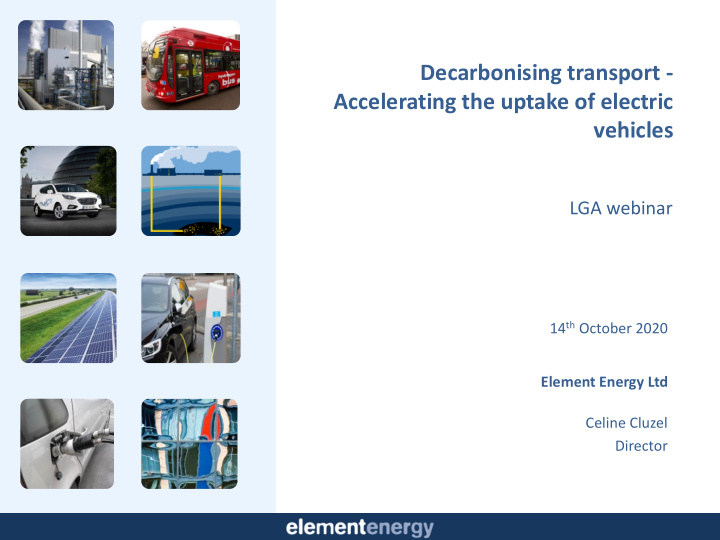



Decarbonising transport - Accelerating the uptake of electric vehicles LGA webinar 14 th October 2020 Element Energy Ltd Celine Cluzel Director
Agenda and introduction Agenda About Element Energy • Specialist energy consultancy, with an excellent reputation • Recap barriers – which for rigorous and insightful analysis are most relevant to • Boroughs We consult on both technical and strategic issues – our technical and engineering understanding of the real-world challenges support our strategic work and vice versa • Examples of concrete • Numerous studies on EVs for local government (typically actions that can be taken infrastructure but also Net Zero targets), central government (e.g. DfT, Transport Scotland, CCC) and private sector • Discussion 2
Barriers to EV uptake have vastly decreased but actions are still needed Barrier group Status LA level of influence Examples or comments Supply of new and used Major Limited EVs barrier High upfront cost Decreasing Limited London scrappage schemes with added cost support for EVs • Lack of knowledge and Significant Role of play Business Breathes campaign • misconceptions barrier Haringey telematics programme • Increase exposure to EVs through taxis and car clubs • Awareness through ‘nudge’ policies e.g. preferential treatment for EVs • Be consistent with use of ‘clean’, ‘green’, ‘low carbon’ Charging infrastructure Variable Role to play Include provision of infrastructure, strength access to it, ease of use, impact on charging networks etc. • Challenge to scoping local support measures for EVs: risk of supporting car ownership/use 3
Example 1 - Business Breathes – a communication campaign run for Birmingham City Council for businesses • Original aim: support business as they prepare for Birmingham’s Clean Air Zone (air quality focus) • Revised aim: Promote zero emission vehicle options / refuelling infrastructure to Birmingham businesses, in light of the city’s Climate Emergency declaration (climate change focus) • Very positive feedback received from FTA, FSB, RHA, coach bodies, BVRLA, etc. • Targeted • Simple language • Source of information for support programmes (central and local) • Refuelling maps • Market availability • Case studies • Social media campaign (Twitter, Linked In) https://businessbreathes.co.uk/ 4
Example 2 - Haringey Council – telematics service for fleet (and resident) to understand if an EV would fit their needs • Background: In 2017, Haringey Council was awarded funding Arriva buses to support a range of ULEV initiatives under the • Service used by support fleet ‘ Neighbourhoods of the Future’ programme. As part of this • 29 of their ferry vehicles are suitable for programme, the council is providing free telematics services switching to EVs with significant cost savings for local users of vans via the company CleanCar. (£20-30 per month per vehicle) • • How it works: Currently in the process of switching – those that can be replaced quickly are being – Real-world driving data collected by GPS for 2 weeks to 3 replaced, the remainder are waiting until months expiry of their current lease – Data compared to current low emission vehicles – User receives a report detailing their suitability to switch, Haringey own fleet recommended vehicles, estimated impact (cost and • The service showed that the EV market for emissions savings) and charging infrastructure the Park service’s larger vans is not mature enough recommendations. • Vehicles are now leased on a shorter basis to • enable a switch to EVs once there are Target users: appropriate vehicles available – Large fleets: initially 5 fleets (~50 vehicles) including • Fleet manager has become more Arriva buses, Haringey Council’s own Parks service, AMEY, interested/engaged with the concept of and a large housing association. ULEVs – Small and microbusinesses (1 – 5 vans) and residents – second phase launched in summer 2020 Funding from Mayor of London and TfL 5 £2-30 per user depending on which technology (mobile app or dongle) and period of time monitoring (2 weeks – 3 months)
Charging infrastructure – understanding the local needs should be the first step • • Many aspects of charging infrastructure are for central DNOs conduct detailed modelling of government, e.g. provision on the Strategic Road future electricity demand, to plan for Network, home charging grant investment need. Access to data can be a barrier to the modelling accuracy. • Actions LAs can take: • Data that Councils can share/help – Understand the needs : quantify households w/o aggregate in order of priority: off street parking, understand local parking and – travel behaviour, assess private sector level of Plans for public charging provision, step up simple forms to collect & map infrastructure deployments (e.g. residents requests plans for PV powered EV charging in new town centre car parks) – Assess opportunities: list/map the Council car – parks and Council land – the development might Data relating to where vehicles park be taken on by private sector (e.g. mapping layers of council owned car parks, recreation centres) – Support grid investment by sharing data with – local DNO : see blue box Plans for introduction of car clubs and conditions on being electric – Support innovation – on-street technologies still – in development, consumer research lacking. Plans relating to modal shift Council can join funded programmes, STEP – Point of Interest location example – Known plans from private sectors • Many risks around charging infrastructure investments (e.g. supermarkets, car park – best to favour/prioritise low regret groups such as operators) shared mobility (e.g. car clubs, taxis) DNO: Distribution Network Operator 6
Thank you for your attention Any questions? • Any questions to be discussed now? • Contact details: Celine.Cluzel@element-energy.co.uk Some related reports available on our website: • Cycle logistics study, 2019, for Central London Boroughs • Ultra-low emissions vehicles market segmentation, 2019, for Transport Scotland & ClimateXChange • Electric Vehicle Charging Behaviour Study, 2019, for National Grid 7
Recommend
More recommend